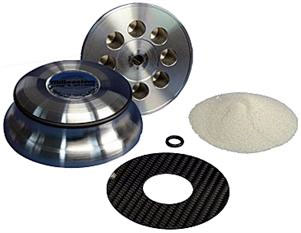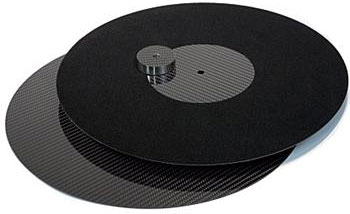
The carbon fiber mat is both to absorb vibrations and to provide an “electrical shielding effect.” All that I can say is that it works. The Millennium M-LP-Mat with a small record puck (not used in this review) costs $349.
The Millennium Silentor LP Weight Support is machined stainless steel, with a tight coupling to the spindle through an O-ring and a series of precision-drilled, silica-filled holes covered by the carbon fiber mat at the record surface. This all provides resonance dampening. The Millennium Silentor costs $349.
I used both on my reference Shindo Labs/Garrard 301 vinyl system. The Shindo has its own excellent record weight as well as an integrated record mat depressed into its special record platter. I had to use the Millennium M-LP-Mat on top of the Shindo mat as the Shindo mat cannot be removed and, even were it removed, there would be a depression that the Millennium would not fill. The Millennium Silentor, of course, can be easily used with the Shindo Labs vinyl system.
Most Millennium products share the use of carbon fiber and stainless steel. Since I have already praised the Millennium CD mat, that uses only carbon fiber, I assume that it is the vital ingredient for sonic performance.
While I did some minor comparisons of the Millennium and Shindo record weights with and without the Millennium M-LP-Mat record mat, the review focuses exclusively on using both Millennium products versus using neither.
One of the greatest complications in this review was raising the VTA, as the Millennium record mat is .3 mm thick. The Shindo Labs is basic and affords no calibration of the arm’s height. I had to seek the same VTA with and without the Millennium mat. After repeated efforts to raise the tone arm .3 mm accurately with the Millennium mat on versus with it off, I resorted to using my ears, seeking the same sense of openness.
I ultimately picked three records for doing this evaluation. The Belafonte Returns to Carnegie Hall, a 200-gram reissue by Classic Records presents a great live recording with much location information. I mainly used the first two cuts, “Jump Down Spin Around” and “Suzanne” and the applause around them. Astrud Gilberto with Gil Evans, Look to the Rainbow is also a reissue by Vivante Productions. Again I used the first two cuts, “Berimbou” and “Once Upon A Summertime”. The first seems poorly recorded. This One’s For Blanton with Duke Ellington and Ray Brown on 45-rpm dual disk reissue by AcousTech is clean, dynamic, and closely miked recording. The piano is key here.
What you hear with the Millennium combo is greater authority in the bass and more depth in the image or soundstage. There also is more detail and darker background, which in my experience are two sides of the same coin. In the case of the Belafonte recording, this all meant more realistic applause and greater separation on the first cut of the first side between him and the background singers PLUS more awareness of street noise outside Carnegie Hall, several instances of a subway approaching, stopping, and then departing, and coughing in the audience. Your seat is, of course, center stage with the strange perspective of both the audience and the performers in front of you. The realism with the Millennium record mat and weight is remarkable on the Ellington/Brown recording. Ellington plays a honky-tonk sounding piano, which must have been an artistic decision. Ray Brown’s bass is closely miked. Both instruments sound more present and true with the Millennium.
On the Gilberto/Evans album, the first cut of the first side one becomes more aware of the recording hall and the presence of an orchestra waiting for its time to join the music. Without the Millennium mat and weight, the recording seems dominantly to the right with no sense of a recording stage. On the second cut, “Once Upon a Summertime”, more instruments are obvious in the recording and it takes on a more complete soundstage.
On all recordings, I prefer the slick side up for greater transparency in the recording. The velvet side is a hair softer and quieter but at the expense of pace and realism. The leading edge is somewhat blunted also.
The Shindo Labs record mat and weight are difficult competition and acquit themselves well. Nevertheless, one cannot ignore the improvement with the Millennium combo. Seven hundred dollars is not a small investment for improved vinyl reproduction, but I find it quite worthwhile and am purchasing my review samples.
- (Page 1 of 1)

